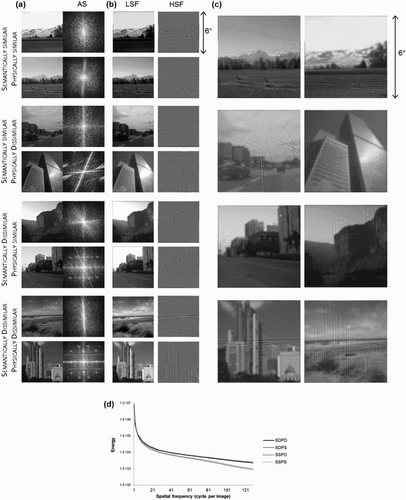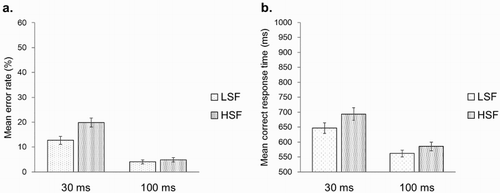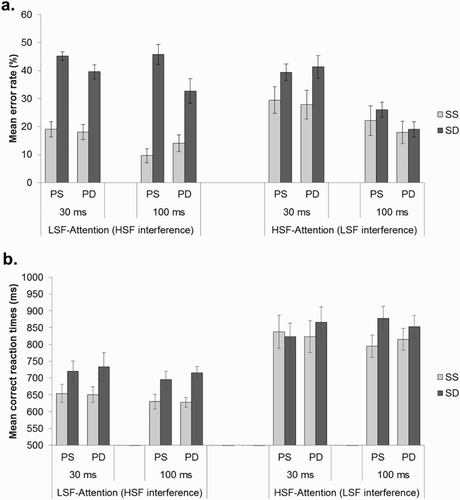Figures & data
Figure 1. (a) Examples of black and white of photographs of scenes used with their amplitude spectrum (AS). On the amplitude spectrum images, low spatial frequencies (LSF) are close to the centre and high spatial frequencies (HSF) are on the periphery. (b) In the Individual scene experimental session (Session 1), we presented artificial and natural scenes filtered in LSF of in HSF. All participants had to categorize LSF and HSF scenes. (c) Examples of the stimuli used in the Hybrid experimental session (Session 2). Hybrid scenes were made by adding a LSF scene and a HSF scene. The two scenes in hybrids were either (1) semantically and physically similar (SSPS; e.g., LSF of a natural scene superimposed with HSF of another natural scene with similar physical properties), (2) semantically similar and physically dissimilar (SSPD; e.g., LSF of a man-made scene superimposed with HSF of another man-made scene with dissimilar physical properties), (3) semantically dissimilar and physically similar (SDPS; e.g., LSF of a natural scene superimposed with HSF of a man-made scene with similar physical properties), or (4) semantically and physically dissimilar (SDPD; e.g., LSF of a natural scene superimposed with HSF of a man-made scene with dissimilar physical properties). Half of the participants had to attend and categorize the LSF scene in hybrids (LSF-Attention) whereas the other half had to attend and categorize the HSF scene (HSF-Attention). (d) Mean energy distribution across spatial frequencies of images in the four experimental conditions (SDPD, SDPS, SSPD, SSPS).

Figure 2. (a) Mean error rates (in %) and (b) mean correct response times (in ms) for the categorization of the individual scenes filtered in LSF and in HSF, for exposure duration of 30 and 100 ms. Error bars indicate standard error.

Figure 3. (a) Mean error rates (in %) and (b) mean correct reaction times (in ms) for the categorization of hybrids according to the Semantic similarity of scenes in hybrids (semantically similar-SS, semantically dissimilar-SD), their Physical similarity (physically similar-PS, physically dissimilar-PD), their Exposure duration (30 or 100 ms), and the Attentional condition (LSF-Attention, HSF-Attention). Error bars indicate standard error.

